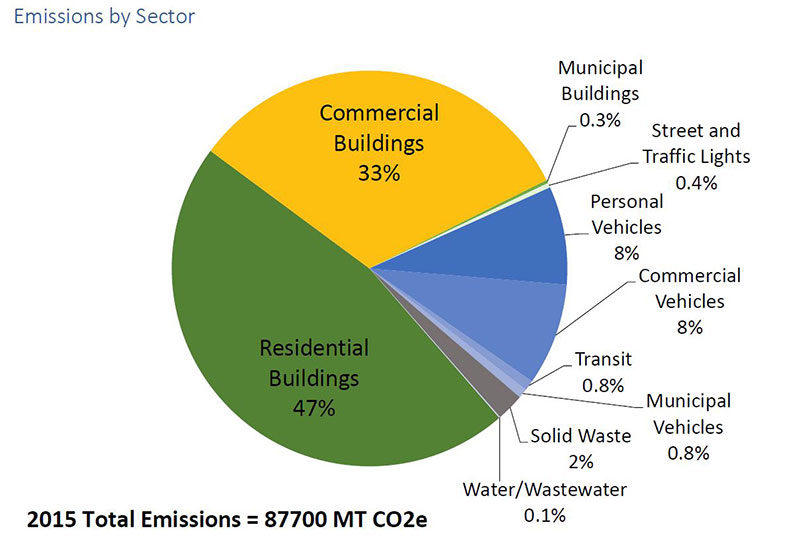
The State of Sustainability in Takoma Park
By Gina Mathias, sustainability manager, City of Takoma Park
Recent reports from the International Panel and Climate Change (IPCC) and the National Climate Assessment have made clear that the world has run out of time on climate change. The reports also indicate that greenhouse gas emissions are the greatest catalyst of climate change. In light of the reports, we must ask ourselves and the City: Are we doing enough to address our greenhouse gas (ghg) emissions?
What ghg reduction strategies should we pursue in 2019?
As many cities do, Takoma Park completes ghg inventories on a three-year cycle. The City completed an update in 2012
and 2015, and the 2018 update will be completed in late 2019 when data becomes available. Despite tremendous efforts and participation in voluntary City-sponsored programs, emissions rose about 2 percent in Takoma Park from 2012 to 2015. There are many factors that affect emissions, including population (per capita emissions) and weather. Taking into account a 15 percent increase in Cooling Degree Days and an 8 percent increase in Heating Degree Days (that means 2015 had harsher weather than 2012), the residential emissions actually went down 10 percent. But is the 10 percent reduction enough? If not, what else can the City do to get bigger reductions in emissions?
First, we should look at what Takoma Park has already done to reduce emissions. Since Takoma Park adopted its
Sustainable Energy Action Plan (SEAP) in 2014, it has:
- won third place in the national Georgetown University Energy Prize Competition for its municipal efforts and its voluntary residential energy efficiency programs;
- completed free energy efficiency projects for lo
w to moderate income home-owners; - won a Metropolitan Council of Governments award for climate and energy;
- been named Sustainability Champion in 2017 by the Sustainable Maryland Certified program;
- approved the conversion of nearly all streetlights in Takoma Park to LED;
- offered grants and programs for multifamily buildings to increase energy efficiency;
- hosted solar co-ops to increase solar installations in the City;
- hosted an annual sustainability challenge for residents that has included an energy efficiency challenge, transportation challenge, and a challenge to switch to 100 percent renewable electricity;
- installed 13 electric vehicle charging stations powered by 100 percent wind;
- increased the availability of bike share and bike lanes
- ;
- worked with local businesses in an energy efficiency campaign;
- increased public outreach and education through major events and workshops; and
- implemented nearly all of the 17 key strategies to reduce greenhouse gas (ghg) emissions from the 2014 plan.
Through Montgomery County and state programs, residents and business have access to additional rebates and financial incentive programs to improve energy efficiency and install renewable energy systems. Businesses in Takoma Park can become Certified Green Businesses, and they have access to both Commercial PACE (property assessed clean energy) and a Green Bank for financing sustainable projects. The City also offers curbside food waste collection, has banned plastic bags, polystyrene food service containers and cosmetic lawn care pesticides, and has an ordinance to protect the urban tree canopy. Sometimes it seems there isn’t much the City isn’t doing.
One of the biggest hurdles in reaching regional goals for ghg reductions is that renewable electricity sources are not the default options for residents and businesses – they are opt-in programs. If the Maryland Public Service Commission allowed municipalities like Takoma Park to create an opt-out Community Choice Aggregation (CCA) program with 100 percent renewable electricity, then Takoma Park could go from having approximately 20 percent of residents and businesses buying renewable electricity to having nearly 100 percent do so.
Aside from greening the power grid itself, we need to focus on where the most emissions in Takoma Park come from. Buildings in the City account for 80 percent of emissions. About 47 percent of emissions come from single family homes, with 33 percent from commercial and multifamily buildings, and less than 1 percent from municipal buildings. (See chart)
Even the most wildly successful voluntary programs hit a plateau of participation and effectiveness. Takoma Park implemented one of the country’s most successful voluntary residential programs with 20 percent of single family homes participating at some level. However the actual ghg emission data suggests that the realized reductions in emissions from the program are only a fraction of what was estimated and what is needed to make a real difference.
State-mandated utility sponsored programs, such as Home Performance with Energy Star home energy audit program and the free Quick Home Energy Check-up program, are great resources, but after 10 years, only about 25 percent of single family homes in Takoma Park have gotten either service, and only 5 percent have made significant energy efficiency improvements to their homes (insulation, air sealing, etc.), despite additional City-based incentives and outreach. In addition, 63 businesses participated in an energy efficiency assessment project. However, like homeowners, most business owners in Takoma Park have not made any significant energy efficiency improvements.
So what are other cities and counties doing? Montgomery County requires large commercial properties to benchmark their energy use. Soon Washington, D.C., will require large commercial properties to meet a minimum energy efficiency standard. Boulder, Colorado, requires all rental units to meet a minimum energy efficiency standard. Portland, Oregon, and Berkeley, California, require single family homes to get a Home Energy Score when a home is listed for sale or sold.
The big “players” in sustainability are moving towards mandatory programs and policies to achieve the aggressive carbon reductions we need according to the recent reports. Why not Takoma Park? If the City implemented minimum energy efficiency standards for all buildings, it could significantly reduce emissions since buildings make up 80 percent of emissions in the City. Energy efficiency is one of the best methods for reducing emissions. With very careful research, planning and consideration, a minimum energy efficiency standard for all can include assistance for low-income homeowners and business owners, improve resilience to extreme weather events and spur further innovation for small cities fighting climate change.
This year the City’s Sustainable Energy Action Plan is due to be updated. This process will include public meetings and community conversations to enable a variety of voices, opinions, and ideas to inform the new plan. The new generation of climate and energy plans calls for aggressive action. Will the City be ready for this next level of action? What ideas do you have to bring to the community conversations?
To stay up to date on Sustainability programs in Takoma Park visit takomaparkmd.gov/sustainability.
This article appeared in the February 2019 edition of the Takoma Park Newsletter. The Takoma Park Newsletter is available for download here.

